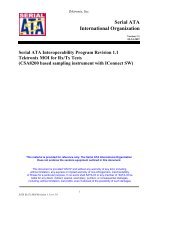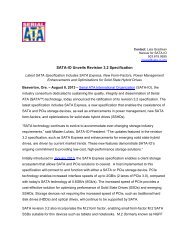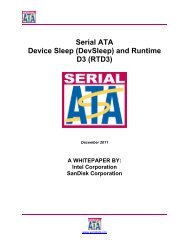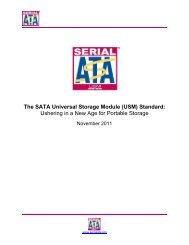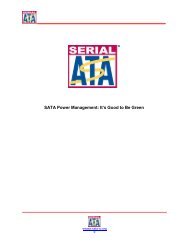1.0 - SATA-IO
1.0 - SATA-IO
1.0 - SATA-IO
- No tags were found...
You also want an ePaper? Increase the reach of your titles
YUMPU automatically turns print PDFs into web optimized ePapers that Google loves.
Test RSG-01 - Gen1 (1.5Gb/s)Receiver Jitter TestTektronix, Inc.Detailed TestsPurpose: To verify that the <strong>SATA</strong> Gen1 and Gen2 PUT will receive a 1.5Gbps stressed data pattern withoutreceive errors.References:[1] <strong>SATA</strong> Standard revision 2.5, 7.2.1, Table 24 – Lab-Sourced Signal (for Receiver Tolerance Testing)[2] Ibid, 7.2.2.6.7 –[3] Ibid, 7.3 - Jitter[4] Ibid, 7.4.1 – Frame Error Rate[5] Ibid, 7.4.9 – Receiver Tolerance[6] <strong>SATA</strong> unified test document, 2.15.1Resource Requirements:See appendix ASignal Calibration:See appendix C.3 for Amplitude calibration Note: this step should precede the Jitter Calibration steps.See appendix C.1 for Rj calibrationSee appendix C.2 for Tj calibrationSee appendix C4 for Transition time validation.Last Template Modification: September 6, 2006 (Version <strong>1.0</strong>)Discussion:Reference [1] specifies the general RSG conformance limits for <strong>SATA</strong> devices. This specification includesconformance limits for the Receiver Amplitude. Reference [2] provides the definition of Frame Error Rate for thepurposes of <strong>SATA</strong> receiver testing. Reference [4] defines the measurement requirements for this test.Test Setup:Connect equipment as shown in Appendix B, figure 1 or 2 as appropriate.Use AWG Framed Long COMP Receiver Test Pattern library of stressed data patterns outlined in Appendix D. Thislibrary includes 1.5Gbps stressed patterns with sine Dj source frequencies of:10MHz33MHz62MHzTest Procedure:This procedure should be applied to the worst case port (in a multi-port system/host) as determined through theworst case port identification MOI.If necessary, use ancillary equipment to place the <strong>SATA</strong> product-under-test (host or drive) in BIST-L mode .Note: In most cases the AWG will complete the entire process from OOB sequencing to BIST-L, and finally issuinga repeating Framed COMP pattern. In certain cases, it may be necessary to use ancillary equipment to properlyinitiate BIST-L modes of operation..Once in BIST-L mode, connect the AWG to the PUT.6 Tektronix <strong>SATA</strong>-<strong>IO</strong> Rev 1.2 RSG MOI v<strong>1.0</strong>




